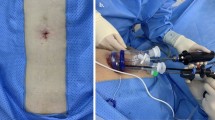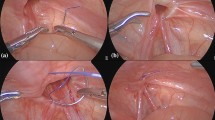Abstract
Background
Inguinal hernia repair is one of the most frequently conducted surgical procedures worldwide. Totally extraperitoneal (TEP) hernioplasty has shown many advantages over traditional open surgery. However, because of increased surgical complexity, it requires more practice to achieve optimal results.
Objectives
The aim of this study is to evaluate the learning curve for TEP hernioplasty, analysing parameters related to the mean operating time. The secondary objective is to assess the complications and early discharge rates related to this procedure.
Methods
A prospective study of 238 consecutive patients undergoing TEP hernioplasty from the same practitioner between May 2009 and May 2014, in a specialised centre for abdominal hernias in Sao Paulo, Brazil, was conducted. All data were obtained through medical records.
Results
The study included 137 patients undergoing a total of 157 TEP hernia repairs. Bilaterality and complications can influence the operating time and so were excluded. Patients with unilateral surgery and without complications were included. Patients were chronologically divided into four groups. Groups 1–3 were composed of 35 patients and group 4 of 32. There were no significant variations in clinical characteristics between the groups. The plateau of the learning curve was reached on the 65 th repetition of the surgery, with a mean operating time of 28 min (p < 0,05). Complications were only observed in the first group of 35 patients. 97% of patients were discharged early, defined as patient leaving hospital less than 12 h after surgery.
Conclusion
After an initial reduction, the mean operating time stabilised after 65 cases. A reduction in the rate of complications was observed after 35 cases, and a rate of 97% of early discharge was achieved.




Similar content being viewed by others
References
Ramanan B, Maloley BJ, Fitzgibbons RJ Jr (2014) Inguinal hernia: follow or repair? Adv Surg 48:1–11
Meyer AL, Berger E, Monteiro O Jr, Alonso PA, Stavale JN, Gonçalves MP (2007 Jul–Sep) Quantitative and qualitative analysis of collagen types in the fascia transversalis of inguinal hernia patients. Arq Gastroenterol. 44(3):230–234.
Iuamoto LR, Kato JM, Meyer A, Blanc P. (2015) Laparoscopic totally extraperitoneal (TEP) hernioplasty using two trocars: anatomical landmarks and surgical technique. ABCD Arq Bras Cir Dig 28(2):121–123. (online)
Ministério da Saúde. DATASUS. Sistema de Informações Hospitalares do SUS (SIH/SUS) data (2013). Available on the website: http://www.tabnet.datasus.gov.br. Accessed 6 Oct 2015.
Mustafa H, Fatih B, Aylin A, Orhan A (2014) A new proposal for learning curve of TEP inguinal hernia repair: ability to complete operation endoscopically as a first phase of learning curve. Minim Invasive Surg 2014:5 (Article ID 528517).
Meyer A, Dulucq JL, Mahajna A (2013 Jan-Mar) Laparoscopic totally extraperitoneal hernioplasty with nonfixation of three-dimensional mesh: Dulucq’s technique. Arq Bras Cir Dig 26(1):59–61.
Kassir R, Tiffet O, Bourbon M, Meyer A, Gugenheim J, Debs T et al (2015 Aug) Laparoscopic hernia repair with 3-millimeter instruments: a point of technique and illustrative case video. Surg Innov 22(4):366–367
Putnis S, Berney CR (2012 Dec) Totally extraperitoneal repair of inguinal hernia: techniques and pitfalls of a challenging procedure. Langenbecks Arch Surg 397(8):1343–1351
Lim JW, Lee JY, Lee SE, Moon JI, Ra YM, Choi IS, et al. (2012 Aug) The learning curve for laparoscopic totally extraperitoneal herniorrhaphy by moving average. J Korean Surg Soc 83(2):92–96.
Meyer A, Dulucq JL, Mahajna A (2013 Jan-Mar) Laparoscopic hernia repair: nonfixation mesh is feasibly? Arq Bras Cir Dig 26(1):27–30.
Bittner R, Schwarz J (2012 Feb) Inguinal hernia repair: current surgical techniques. Langenbecks Arch Surg 397(2):271–282
Meyer A, Blanc P, Balique JG, Kitamura M, Juan RT, Delacoste F, et al (2013 Jan-Feb) Laparoscopic totally extraperitoneal inguinal hernia repair: twenty-seven serious complications after 4565 consecutive operations. Rev Col Bras Cir 40(1):32–36.
Meyer A, Blanc P, Kassir R, Atger J (2014 Jul-Sep) Laparoscopic hernia: umbilical-pubis length versus technical difficulty. JSLS 18(3): e2014.00078.
Lal P, Kajla RK, Chander J, Ramteke VK (2004 Apr) Laparoscopic total extraperitoneal (TEP) inguinal hernia repair: overcoming the learning curve. Surg Endosc 18(4):642–645
Ebbinghaus H (1885) Memory: a contribution to experimental psychology (Henry A. Ruger & Clara E. Bussenius, Trad.). Original publicado em New York: Teachers College, Columbia University. (Original em alemão “Über das Gedächtnis”, publicado em).
Khan N, Abboudi H, Khan MS, Dasgupta P, Ahmed K (2014 Mar) Measuring the surgical ‘learning curve’: methods, variables and competency. BJU Int 113(3):504–508
Dyer C (2001 Jul 28) Bristol inquiry condemns hospital’s “club culture”. BMJ 323(7306):181.
Hopper AN, Jamison MH, Lewis WG (2007) Learning curves in surgical practice. Postgrad Med J 83:777–779
Choi YY, Kim Z, Hur KY (2012 Feb) Learning curve for laparoscopic totally extraperitoneal repair of inguinal hernia. Can J Surg 55(1):33–36
Simons MP, Aufenacker T, Bay-Nielsen M, Bouillot JL, Campanelli G, Conze J et al (2009 Aug) European Hernia Society guidelines on the treatment of inguinal hernia in adult patients. Hernia 13(4):343–403
Schouten N, Elshof JW, Simmermacher RK, van Dalen T, de Meer SG, Clevers GJ et al (2013 Dec) Selecting patients during the “learning curve” of endoscopic Totally Extraperitoneal (TEP) hernia repair. Hernia 17(6):737–743
Park BS, Ryu DY, Son GM, Cho YH (2014 Oct) Factors influencing on difficulty with laparoscopic total extraperitoneal repair according to learning period. Ann Surg Treat Res 87(4):203–208
Koning GG, Wetterslev J, van Laarhoven CJHM, Keus F (2013) The totally extraperitoneal method versus Lichtenstein’s technique for inguinal hernia repair: a systematic review with meta-analyses and trial sequential analyses of randomized clinical trials. Biondi-Zoccai G, ed. PLoS ONE 8(1):e52599
Schouten N, Simmermacher RK, van Dalen T, Smakman N, Clevers GJ, Davids PH et al (2013 Mar) Is there an end of the “learning curve” of endoscopic totally extraperitoneal (TEP) hernia repair? Surg Endosc 27(3):789–794
Meyer A, Bonnet L, Bourbon M, Blanc P (2015 Jun) Totally extraperitoneal (TEP) endoscopic inguinal hernia repair with TAP (transversus abdominis plane) block as a day-case: a prospective cohort study. J Visc Surg 152(3):155–159
Acknowledgements
The authors are thankful to João Italo Dias França for assistance with statistical analysis and to Justin Axel-Berg for the English corrections.
Author information
Authors and Affiliations
Corresponding author
Ethics declarations
Disclosures
Fábio Yuji Suguita, Felipe Futema Essu, Lucas Torres Oliveira, Leandro Ryuchi Iuamoto, Juliana Mika Kato, Fernanda Cotrim, Matheus Beloni Torsani, André Silva Franco, Alberto Meyer and Wellington Andraus have no conflicts of interest or financial ties to disclose.
Rights and permissions
About this article
Cite this article
Suguita, F.Y., Essu, F.F., Oliveira, L.T. et al. Learning curve takes 65 repetitions of totally extraperitoneal laparoscopy on inguinal hernias for reduction of operating time and complications. Surg Endosc 31, 3939–3945 (2017). https://doi.org/10.1007/s00464-017-5426-z
Received:
Accepted:
Published:
Issue Date:
DOI: https://doi.org/10.1007/s00464-017-5426-z




